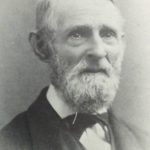This article is part of the digital exhibit Brass City/Grass Roots: The Persistence of Farming in Waterbury, Connecticut. Use the arrows at the bottom of the page to navigate to other parts of the exhibit.
Deciphering the Landscape Today
There are many remnants of Waterbury’s farming heritage. Some are easy to spot; others are harder. Here is one example:
Driving through Waterbury, you have probably passed this stone arch at the corner of Manor Avenue and Wolcott Street dozens of times without knowing that it is a remnant of the border of a 19th century Waterbury farm carved by the farmer himself. Hobart Victory Welton (1811-1895) was a member of one of Waterbury’s oldest families. Welton was not just a farmer but also a city engineer, a politician, a brass industry entrepreneur, and a wood and stone carver. Welton’s farm lay between Wolcott Street and Meriden Road. Other Welton family properties were scattered throughout Waterbury.
- Hobart Welton’s house on Wolcott Street, the stone arch is on the left side of the road – Courtesy of the Mattatuck Museum, click to enlarge
- Portrait of Hobart Welton – Illustration by Joseph Anderson in The Town and City of Waterbury, Connecticut, click to enlarge
“As we look to the future we are trying to connect people to what was and what could be again. What was the norm forty and fifty years ago seems almost innovative now, but it really is our history coming to life and that is what this exhibit is teaching people.”
—Sue Pronovost, Executive Director of Brass City Harvest
But, of course, the story doesn’t end there. Independent local farming has never entirely died in Waterbury; a few people, particularly in the Buck’s Hill area of the city, continue to keep animals. Laws such as Connecticut’s Public Act 490, instituted in 1963 to tax farmland by its use value rather than by its development or market value, have eased the soaring tax burden on farmers and provided encouragement to pockets of people to keep farming or start farms. In Waterbury, local laws permit residents to keep some farm animals if they have at least one acre of property. Self-described hobby farmers—such as Susan Kather of Buck’s Hill—have kept horses, poultry, rabbits, and goats, while working other jobs to earn a living. Slightly south of Buck’s Hill, members of the Becce family still grow produce and raise animals.
In recent decades, many have begun to question both the health and the environmental costs of corporate food production and of trucking food in from long distances, and to reconsider the benefits of locally grown food. From the 1980s to the present, community gardens and farmers’ markets have popped up from time to time on vacant lots in urban neighborhoods, often sponsored by neighborhood activists in conjunction with local community organizations such as Brass City Harvest, Neighborhood Housing Services of Waterbury, and the Osher Lifelong Learning Institute at the University of Connecticut’s Waterbury campus.
Recent federal and state legislation and assistance from the Connecticut Department of Agriculture has strengthened and sustained such initiatives. Waterbury’s Brass City Harvest (BCH), founded in 2007, is a nonprofit organization that pioneered models of sustainable food production for and by city residents through community gardens, greenhouses, farmers’ markets and, most recently, a mobile produce truck and a food hub where community cooking classes are held. Produce raised by BCH is turned into pies, jams, and other products, and area farmers can package their goods in a sterile, commercial kitchen. BCH is especially focused on serving populations such as those eligible for WIC (The Special Supplemental Nutrition Program for Women, Infants, and Children) and low-income seniors, all of whom can trade coupons for fresh fruits and vegetables. Such efforts to bring back agriculture not only feed local people with thousands of pounds of locally grown produce; they also teach children and youth to work to raise their own healthy food, to interact with nature, and to pool their skills and talents as farm families used to do. Urban farming and food processing has the potential to revitalize neighborhoods and to create local jobs just as it did in the past. It often dovetails with the desires of local residents (many of whom are either immigrants or migrants from places where farming and gardening are still practiced) or longtime residents old enough to remember Waterbury’s past of local food production.
To be successful, those working or interested in modern local food production would do well to draw upon lessons from the past as well as the crises of the present. Might it make sense, in the wake of the departure of most of the city’s brass factories, to consider a revival of the large-scale food production sector once so robust in Waterbury? Consider the example of Ideal Fish, selling 120 tons of ecologically raised branzino fish a year to restaurants and consumers and repurposing fish waste as fertilizer—all done in an East End building that was once part of the Waterbury Button Company. Local entrepreneurs are also involved in olive oil production and have tried to cultivate mushrooms in other industrial areas of the city.
Would it be feasible to have the local government as involved as it once was in making it possible for local food cultivators to process and market their products? Could or would the city encourage enterprising locals to start and sustain their own local food operations? What role can active and informed residents play in the re-greening of Waterbury?
Note: ConnecticutHistory.org does not edit content originally published on another platform and therefore does not update any instances of outdated content or language.












